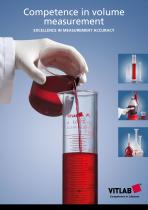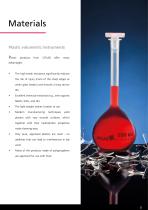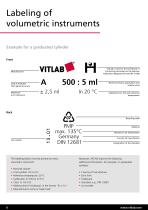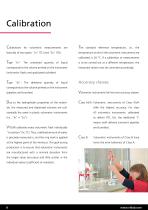 Website:
VITLAB
Website:
VITLAB
Catalog excerpts

EXCELLENCE IN MEASUREMENT ACCURACY
Open the catalog to page 1
Volumetric instruments Volume measurement is of fundamental importance What are volumetric instruments? in the laboratory. Volumetric flasks, graduated cylinders, burettes and pipettes are standard equipment in any analytical laboratory. VITLAB is one volumes are the most frequently used apparatus in of the leading manufacturers of plastic laboratory the laboratory. There is a big difference between products and liquid handling instruments, and offers volumetric instruments for exact measurements, decades of experience in the development and including volumetric flasks, volumetric and...
Open the catalog to page 2
Materials Plastic volumetric instruments Plastic The high break resistance significantly reduces the risk of injury (none of the sharp edges as when glass breaks) and ensures a long service life Excellent chemical resistance (e.g., even against NaOH, KOH, and HF) The light weight makes it easier to use plastics with very smooth surfaces, which together with their hydrophobic properties make cleaning easy • Only pure, approved plastics are used - no additives that can lead to interferences in lab work Many of the products made of polypropylene are approved for use with food
Open the catalog to page 3
Manufacturing the blanks Only the highest quality plastic granulates are used in manufacturing our products, which guarantees that the instruments produced down the line will have the desired properties. Thus, polymethylpentene (PMP) is used exclusively for instruments of accuracy class A (volumetric flasks and graduated cylinders). This high-performance plastic offers nearglass transparency, and very good dimensional stability after the production process. These are two of the critical requirements for producing Class A prod- The fluoroplastic PFA is a special case. Although this ucts....
Open the catalog to page 4
Scales and labeling Techniques Various techniques are used for the labels on our To maintain the long-term readability of the scale, products and for imprinting the scales. Volumetric do not clean imprinted volumetric instruments at flasks and pipettes are imprinted by standard temperatures exceeding 60 °C. Obviously, laboratory methods using high-quality inks, but PFA is an dishwashers can be used. These are gentler than exception because of its surface structure. A special immersion baths. Due to the low weight, we process makes it possible to apply the ring mark recommend using washing...
Open the catalog to page 5
Labeling of volumetric instruments Example for a graduated cylinder Front VITLAB's mark for the Certificate of Conformity according to the German Calibration Regulations and DIN 12 600 Class A indicates the highest accuracy Nominal volume, graduation and volume units Maximum error tolerance Calibration (In, TC) and reference temperature Back Recycling code Material Maximum use temperature Country of manufacture The labeling below must be printed on every volumetric instrument: • Nominal volume • Units symbol: ml or cm³ • Reference temperature: 20 °C • Calibration: Ex (TD) or In (TC) •...
Open the catalog to page 6
Certificates Quality certificate The quality assurance developed according to DIN EN ISO 9001 forms the basis for issuing factory calibration certificates, which serve as the quality certificates. These VITLAB factory test certificates are normally available in the form of a lot certificate, and an individual certificate can be obtained upon request. All test results are documented and archived for at least 7 years, so that individual results for any production times during this period can be accessed when the lot number or serial number is known. Individual certificate Quantity shipped per...
Open the catalog to page 7
Calibration Calibrations standard reference temperature, i.e., the temperature at which the volumetric instruments are calibrated, is 20 °C. If a calibration or measurement “In”: The contained quantity of liquid corresponds to the volume printed on the instrument is to be carried out at a different temperature, the measured values must be corrected accordingly. (volumetric flasks and graduated cylinders). “Ex”: The delivered quantity of liquid Accuracy classes corresponds to the volume printed on the instrument (pipettes and burettes). Volumetric instruments fall into two accuracy...
Open the catalog to page 8
Meniscus setting Comparison of meniscus settings The meniscus refers to the curvature of the liquid surface. The meniscus can curve either downwards or upwards. The shape of the curvature results from the interaction between adhesion and cohesion forces. If the liquid molecules are attracted more strongly to the vessel wall than to one another (adhesion), then the meniscus curves downward. This is true in the example of glass walls and aqueous solutions. If the cohesion forces of a liquid are greater than the adhesive forces of the vessel wall (cohesion), the meniscus will curve upward....
Open the catalog to page 9
Reading the volume Accurate reading During experiments, the volume of a liquid frequently must be read very carefully, because the accuracy of the measurement depends on correctly reading the liquid level on the scale. Important factors for the correct reading are: Level surface The measuring instrument should be secured on the level surface. Burettes should be attached to a tripod and aligned perpendicularly. Avoid liquid droplets It is important to ensure that no liquid droplets adhere to the wall of the instrument, since they can flow downward and thus raise the liquid level. Note: With...
Open the catalog to page 10
Volumetric flasks Working with volumetric flasks Volumetric flasks are mainly used in volumetric volume. After Class A pipettes, they are the most analysis for the preparation of solutions of accurately accurate volume measuring instruments in the known concentration (standard solutions), and for use laboratory due to the slender neck diameter. In in the preparation of calibration series and dilutions. addition to volumetric flasks with the standard joint For this reason, volumetric flasks are calibrated "In" stoppers, VITLAB also offers volumetric flasks with a (TC). They don't have...
Open the catalog to page 11All VITLAB catalogs and technical brochures
-
VITsafe Wash bottles
4 Pages
-
SAVING AND STORING
10 Pages
-
Liquid-Handling range
44 Pages
-
Labware range
164 Pages





